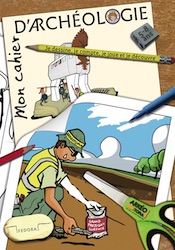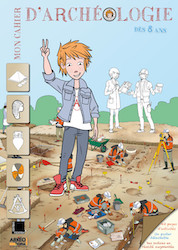Using Archaeology, the Fight against Criminals
- Last Updated: Tuesday, 28 June 2022 09:47
- Published: Friday, 18 February 2022 16:31
- Written by Jean-Olivier Gransard-Desmond translated by Chloé Walot and Leah Gallet
- Hits: 1450
Join Augustin, Alex, Lisa and the whole ArkeoTopia team to discover additional resources for step 8.3 in My Archaeology Book on using archaeological research to fight the illegal trafficking of cultural objects.
Step 8.3 - Using archaeology
Fighting against Illicit Antiquities Trafficking
Corresponding pages in MAB1 and MAB2
MAB 1, p. 37 and MAB 2, p. 45
More about this step’s reference artifact

.gif) The drawing in My Archaeology Book titled Fighting against Illicit Antiquities Trade shows warlord Wang Chuzhi's stele, dating back to the rule of the Tang Dynasty from 863-923 CE. This relic of history was once stolen and then recovered some time later, thanks in-part to the important work of archaeologists in the fight against antiquities trafficking. This important work to safeguard and recover heirlooms of our civilization such as Wang Chuzhi's stele assures the preservation of our history and cultural heritage for generations to come.
The drawing in My Archaeology Book titled Fighting against Illicit Antiquities Trade shows warlord Wang Chuzhi's stele, dating back to the rule of the Tang Dynasty from 863-923 CE. This relic of history was once stolen and then recovered some time later, thanks in-part to the important work of archaeologists in the fight against antiquities trafficking. This important work to safeguard and recover heirlooms of our civilization such as Wang Chuzhi's stele assures the preservation of our history and cultural heritage for generations to come.
Stolen in 1994, the stele originating from Wang Chuzhi’s tomb located in the region of Quyang (China) was found in February 2000 by the American police thanks to the work of expert archaeologists. This is why the policeman in the background is dressed in an American police uniform. It also explains why Lisa, the archaeologist, is holding a magnifying glass in her hand in front of the stele. She was asked to intervene as what we call an expert, or a specialist who is able to provide a well-reasoned argument to explain what are otherwise mysterious circumstances.
Bouh, the owl, keeps guard throughout the night. His night vision makes him a well-equipped caretaker who can surprise looters and who knows how to stop them. Bouh is shown here in action, safeguarding cultural heritage and deterring theft, looting and destruction of artifacts, much in the same way that archaeologists participate in the safekeeping of this heritage. Bouh reinforces the UNESCO logo, designed and drawn by Hartlandvilla. The UNESCO logo isa realistic and simple pictogram aiming to increase public awareness of cultural heritage protection. You can find the logo on the right-hand side of the word “customs” on the building, which is the same shape as the actual UNESCO warehouses where seized objects are stored. Illicit trade of cultural property can arise in a variety of forms, it can involve diverse stakeholders and serve various purposes.
For this reason, the expression “illicit trade of cultural property” or “illicit trafficking of cultural goods” may refer to a wide variety of practices according to current national or international legislation, including those stated by the ICOM International Observatory on Illicit Traffic in Cultural Goods:
- Theft from museums, monuments, religious sites, and other public or privately held conservation locations
- Illicit excavations of archaeological objects during armed conflicts or periods of military occupation
- Illicit export and import of cultural property
- Illegal transfer of ownership of cultural property (sale, purchase, assumption of mortgage debt, exchange, donation or bequest)
- Production, trade, or usage of forged documentation, traffic of fake or forged cultural property
 Several NGOs (Non Governmental Organizations) have cooperated worldwide to help fight against antiquities trafficking and thus protect our civilizations’ cultural heritage.
Several NGOs (Non Governmental Organizations) have cooperated worldwide to help fight against antiquities trafficking and thus protect our civilizations’ cultural heritage.
Some of these NGOs include :
- the United Nations Educational, Scientific and Cultural Organization (UNESCO) with its department of Illicit Trafficking of Cultural Property
- the International Council of Museums (ICOM) which created the Red list tool in order to inventory the vulnerable categories of archaeological objects or works of art in particularly exposed areas of the world so as to prevent them from being sold or illegally exported
These NGOs support public organizations such as:
- international structures including
- Interpol, or the International Criminal Police Organization (ICPO) which works to protect cultural property
- the World Customs Organization (WCO)
- national organizations
- Each country may or may not have one or more specialized services to ensure the protection of cultural heritage and cultural property. In France, the Central office for the Fight against illegal Traffiching in Cultural Goods (Office de lutte contre le trafic de Biens Culturels - OCBC) fulfills this mission in close cooperation with the Customs department and the ministries of Justice and of Foreign Affairs and International Development.
Clues
The aim is to illustrate the expert work of archaeologists when, through their knowledge and skills to carry out an expertise, they help the legal authorities (here, the police officer and the customs service) to ensure the protection of cultural heritage, watch also illustrated by Bouh the owl and the UNESCO logotype, by returning a stolen object to a country, here the stele from Wang Chuzhi’s tomb (China) returned to China in February 2000 by the American authorities.
The 7 clues include:
- The word “stolen” on the stele, and the stele itself
- Bouh the owl
- Lisa, the archaeologist
- The magnifying glass held by Lisa, the archaeologist
- The American police officer handcuffing the thief
- The UNESCO logo
- The word “customs” on the customs warehouse building
Learning HistoryMy Archaeology Book
Resources HomepageMAB Animals
What do They Represent?
 |
 |
|
My Archaeology Book 1 |
My Archaeology Book 2 |

 My Archaeology Book, or MAB, is an activity workbook that combines creativity, fun and learning. Alongside young Augustin, a curious and courageous boy, children meet Alex and Lisa, two friendly archaeologists who will lead them to discover archaeology and French heritage. Each drawing illustrates a situation that Alex and Lisa might encounter at work. Depending on the age of the child and the workbook, children follow easy-to-understand symbols in order to experiment with activities such as coloring, drawing, observation games, riddles and reading in order to see the world through an archaeologist’s eyes. Alone, with family, at school or just for fun, children expand their knowledge and gain skills, all while having fun.
My Archaeology Book, or MAB, is an activity workbook that combines creativity, fun and learning. Alongside young Augustin, a curious and courageous boy, children meet Alex and Lisa, two friendly archaeologists who will lead them to discover archaeology and French heritage. Each drawing illustrates a situation that Alex and Lisa might encounter at work. Depending on the age of the child and the workbook, children follow easy-to-understand symbols in order to experiment with activities such as coloring, drawing, observation games, riddles and reading in order to see the world through an archaeologist’s eyes. Alone, with family, at school or just for fun, children expand their knowledge and gain skills, all while having fun.
On this section, you will find additional resources: color photos of archaeological documents that inspired My Archaeology Book, additional teaching documents (flip-book, websites, suggestions for classroom use, edutainement, etc.) and information on upcoming publications. Each page will be updated over time.






